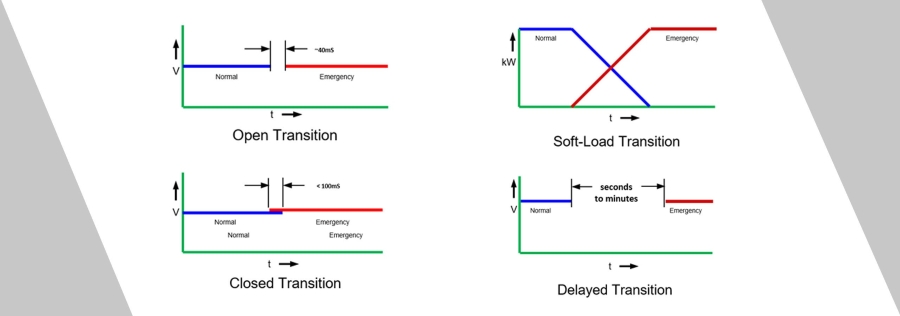- Transfer Mechanism
- Transfer Switch Solutions for Service Entrance
- Transition Modes for Automatic Transfer Switches - Part
Open Transition
Open transition switching is sometimes referred to as “Break-Before-Make”. This term reflects the sequence of switching mechanism operations, where the contacts for the original source are opened before the contacts for the alternate source are closed.
Delayed Transition
Delayed transition switching is primarily used where an Automatic Transfer Switch (ATS) supplies primarily inductive or motor loads. The sequence is similar to open transition switching; however, the duration of the power interruption is extended to allow residual voltages to decay and motors to slow. This avoids the occurrence of large inrush currents when the switch closes on the alternate source.
Closed Transition
Closed transition switching is often termed “Make-Before-Break” because the contacts for the alternate source are closed before the contacts for the original source are opened. This results in momentary source paralleling that provides continuous power, avoiding momentary power interruption to sensitive loads. Closed transition switching requires care to avoid extended interconnection of the sources, and should never be used without consulting utility officials.
Soft - Load Transition
Like closed transition, soft-load transition parallels two power sources. In this mode, however, the sources can be paralleled for extended periods. This highly advanced sequenced is used to decrease loading on the original source while increasing loading on the alternate source. Used only in highly specialized applications, soft-load Automatic Transfer Switch (ATS)’ can be used to avoid both power interruptions and rapid changes in power conditions. Unlike the other modes that are illustrated using voltage, soft-load is best understood by observing temporal changes in power.
Open transition switching is sometimes referred to as “Break-Before-Make”. This term reflects the sequence of switching mechanism operations, where the contacts for the original source are opened before the contacts for the alternate source are closed.
Delayed Transition
Delayed transition switching is primarily used where an Automatic Transfer Switch (ATS) supplies primarily inductive or motor loads. The sequence is similar to open transition switching; however, the duration of the power interruption is extended to allow residual voltages to decay and motors to slow. This avoids the occurrence of large inrush currents when the switch closes on the alternate source.
Closed Transition
Closed transition switching is often termed “Make-Before-Break” because the contacts for the alternate source are closed before the contacts for the original source are opened. This results in momentary source paralleling that provides continuous power, avoiding momentary power interruption to sensitive loads. Closed transition switching requires care to avoid extended interconnection of the sources, and should never be used without consulting utility officials.
Soft - Load Transition
Like closed transition, soft-load transition parallels two power sources. In this mode, however, the sources can be paralleled for extended periods. This highly advanced sequenced is used to decrease loading on the original source while increasing loading on the alternate source. Used only in highly specialized applications, soft-load Automatic Transfer Switch (ATS)’ can be used to avoid both power interruptions and rapid changes in power conditions. Unlike the other modes that are illustrated using voltage, soft-load is best understood by observing temporal changes in power.


